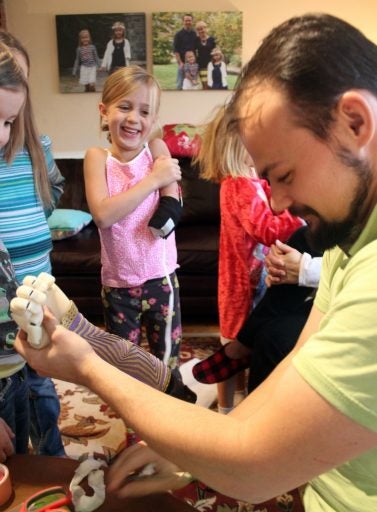Twenty-two – That’s the number of countries represented by the hundreds of calls and emails a team of engineering students at the University of Central Florida has received since they designed and delivered a bionic arm to a 6-year-old boy this past July.
“We receive emails daily asking for help,” said Dominique Courbin, a senior studying to earn his degree in mechanical engineering in 2016 while working and continuing to volunteer his time with the team. “It’s kind of hard to keep up.”
Courbin is one of the original Limbitless Solution team members who designed a 3-D printed arm for Alex Pring for less than $350 and then gave it to him for free. The team then proceeded to upload the designs onto the Internet for anyone to use.
Since then, the team has consulted on several dozen cases around the world via Skype and email. They have custom designed two hands and an arm, and in once case three team members drove straight through the night to Virginia so 7-year-old Madelyn Rebsamen could have her arm by Thanksgiving morning. They are also working on a 4.0 version of an arm with a more functional elbow to give Alex just in time for Christmas.
The busy team members often ask each other what day of the week it is and joke that sleep is “overrated.” Seeing the face of the children and their parents when the children receive an arm makes the long hours and hustle worth it, they say.
“It’s amazing,” said team leader Albert Manero, who is in Germany working on a fellowship tied to his master’s degree in aerospace engineering. “I mean, I’m just a 25-year-old with a laptop in Germany working to make a difference. I’m so happy we can engineer hope for families around the world.”
Despite being thousands of miles away and nowhere near the lab at UCF that the team uses to produce the limbs, Manero has kept moving forward responding to requests and trying to create partnerships that can extend the team’s impact. The team members, including Manero, meet weekly via videoconference to talk about their work and the many requests they receive.
The team is now part of a League of Universities and Institutions that has pledged to share the knowledge to help their local communities. Some of the members include: Liberty University, Rochester Institute of Technology, Johns Hopkins Hospital, Miami Children’s Hospital, University of Southern California, University of Pennsylvania, Humanitarian Prosthetists and Orthotists, JFK Johnson Rehabilitation Institute and Cleveland State University.
Meanwhile, team members at UCF continue to answer emails and troubleshoot with other volunteers – some professional, some students – across the country who have reached out for help
When the team receives an email the members first try to reach out to their partners to see if anyone is closer to the person asking for help. That’s the best-case scenario, said Tyler Petresky, a sophomore majoring in computer engineering and one of the leaders based at UCF. If the team members can, they make the connection and move onto the next name on their list. In some cases, there is no one else and the team starts reviewing the situation and seeing what they can do and how quickly. There are
Then there are those requests that are extremely challenging.
One family reached out because their child has Atelosteogenesis Type 3, a rare disease that causes bone to grow incorrectly, misalign and deviate limbs. Only 20 people are known to have this condition in the world. The family asked the team if they could help with the leg braces the boy uses. Members of the team pooled together and created a senior design team to tackle the problem.
Mateo Alvarez is leading the group and is working with Nemours doctors in Delaware and Orlando to help create a more comfortable brace that will be primarily 3-D printed for the child. The goal is to make the brace and exoskeleton more adaptable and more affordable.
In November, a team of volunteers in Colombia used the team’s work to make an arm for a child. It was the first time the team’s work had been used outside the United States. It was a milestone, but it is only the beginning.
“I have a dream that someday we can work with the U.N. and UNICEF to set up 3-D stations around the world to help every child who can benefit from this,” Manero said. “That would really be something.”
